fuel pressure TOYOTA SIENNA HYBRID 2023 Owners Manual
[x] Cancel search | Manufacturer: TOYOTA, Model Year: 2023, Model line: SIENNA HYBRID, Model: TOYOTA SIENNA HYBRID 2023Pages: 602, PDF Size: 14.9 MB
Page 1 of 602
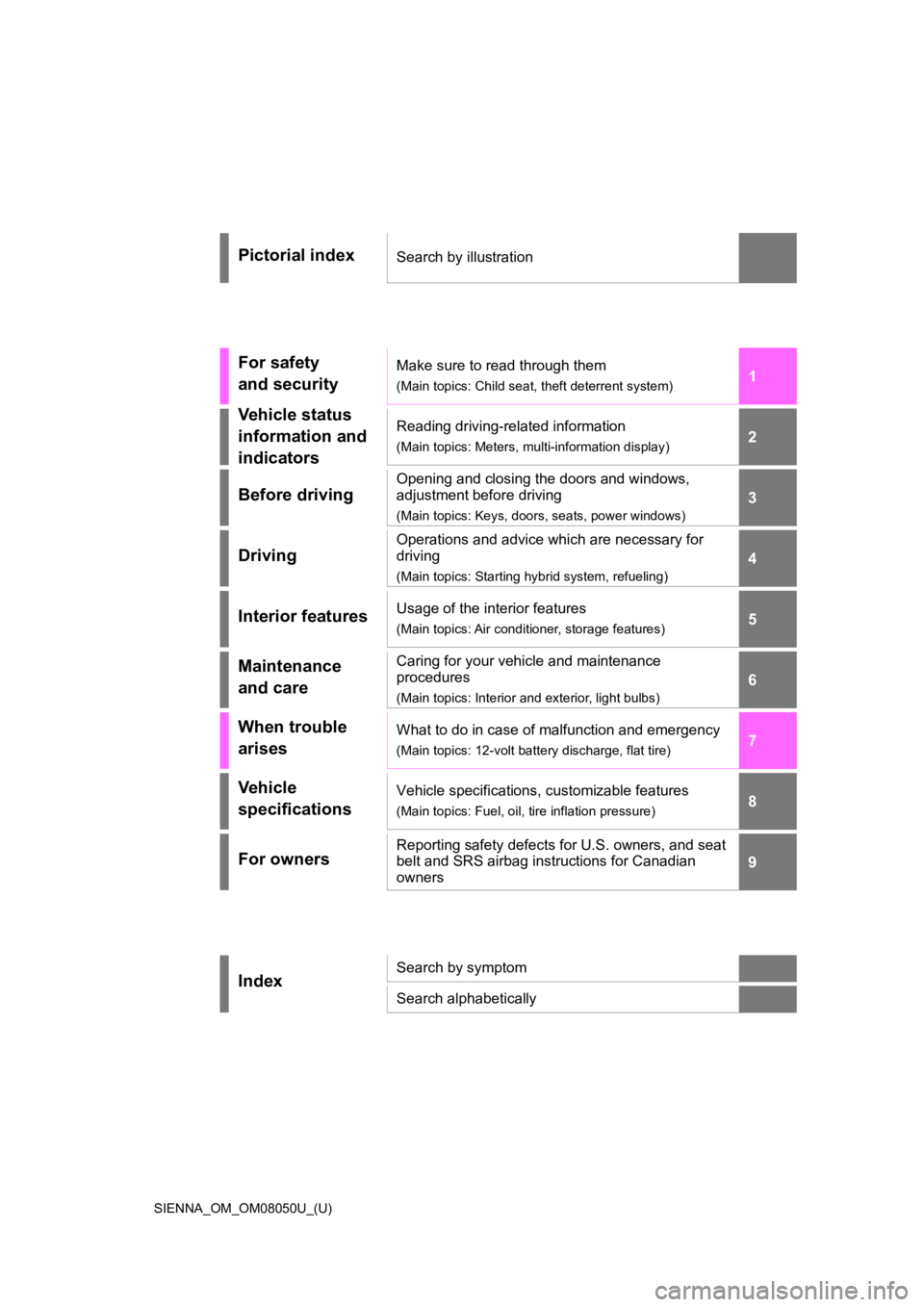
SIENNA_OM_OM08050U_(U)
1
2
3
4
5
6
7
8
9
Pictorial indexSearch by illustration
For safety
and securityMake sure to read through them
(Main topics: Child seat, theft deterrent system)
Vehicle status
information and
indicatorsReading driving-related information
(Main topics: Meters, multi-information display)
Before driving
Opening and closing the doors and windows,
adjustment before driving
(Main topics: Keys, doors, seats, power windows)
Driving
Operations and advice which are necessary for
driving
(Main topics: Starting hybrid system, refueling)
Interior featuresUsage of the interior features
(Main topics: Air conditioner, storage features)
Maintenance
and careCaring for your vehicle and maintenance
procedures
(Main topics: Interior and exterior, light bulbs)
When trouble
arisesWhat to do in case of malfunction and emergency
(Main topics: 12-volt battery discharge, flat tire)
Vehicle
specificationsVehicle specifications, customizable features
(Main topics: Fuel, oil, tire inflation pressure)
For ownersReporting safety defects for U.S. owners, and seat
belt and SRS airbag instructions for Canadian
owners
IndexSearch by symptom
Search alphabetically
Page 4 of 602
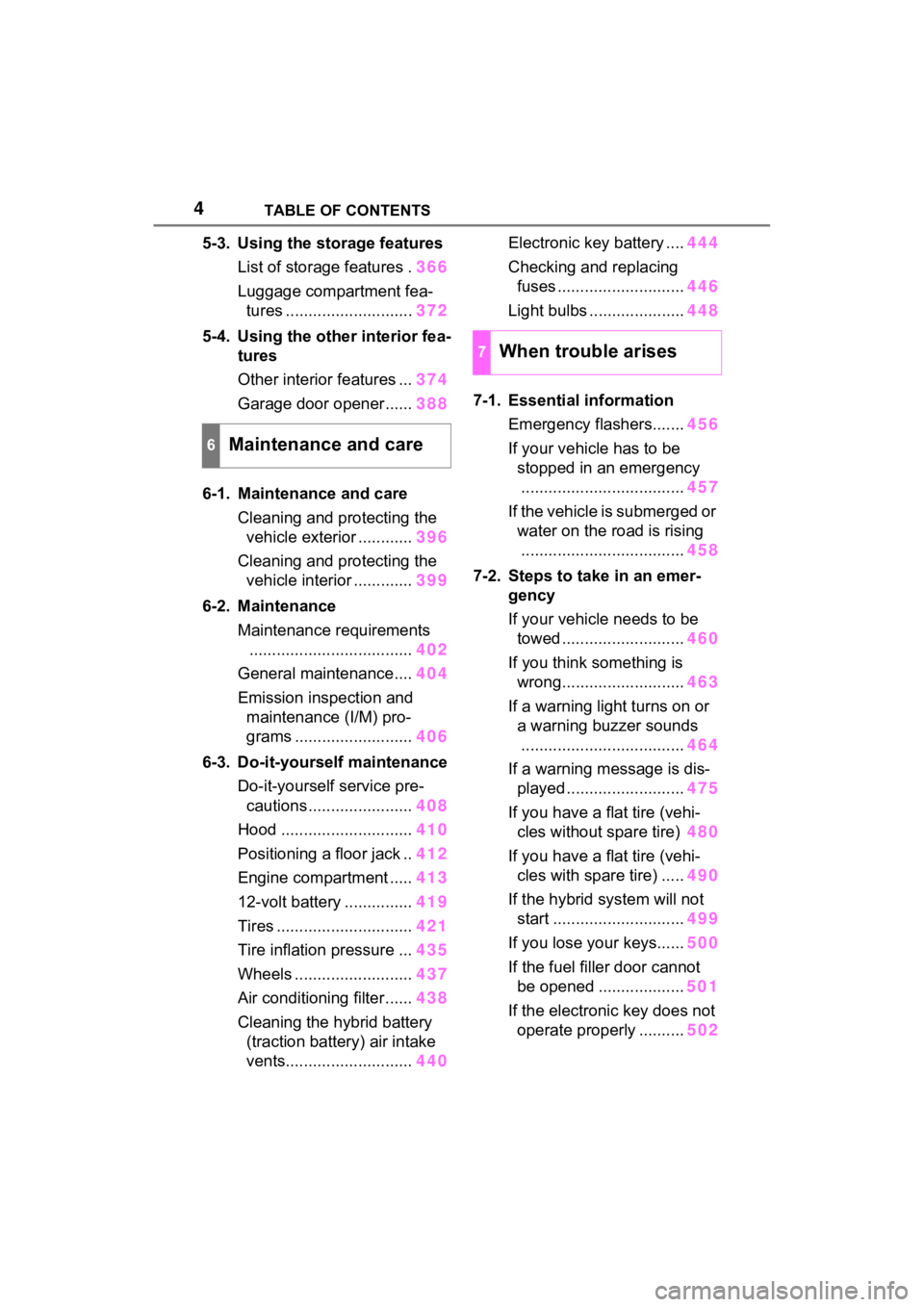
4TABLE OF CONTENTS
5-3. Using the storage featuresList of storage features . 366
Luggage compartment fea- tures ............................ 372
5-4. Using the other interior fea- tures
Other interior features ... 374
Garage door opener...... 388
6-1. Maintenance and care Cleaning and protecting the vehicle exterior ............ 396
Cleaning and protecting the vehicle interior ............. 399
6-2. Maintenance Maintenance requirements.................................... 402
General maintenance.... 404
Emission inspection and maintenance (I/M) pro-
grams .......................... 406
6-3. Do-it-yourself maintenance Do-it-yourself service pre-cautions ....................... 408
Hood ............................. 410
Positioning a floor jack .. 412
Engine compartment ..... 413
12-volt battery ............... 419
Tires .............................. 421
Tire inflation pressure ... 435
Wheels ......... .................437
Air conditioning filter ...... 438
Cleaning the hybrid battery (traction battery) air intake
vents............................ 440Electronic key battery ....
444
Checking and replacing fuses ............................ 446
Light bulbs ..................... 448
7-1. Essential information Emergency flashers....... 456
If your vehicle has to be stopped in an emergency.................................... 457
If the vehicle is submerged or water on the road is rising.................................... 458
7-2. Steps to take in an emer- gency
If your vehicle needs to be towed ........................... 460
If you think something is wrong........................... 463
If a warning light turns on or a warning buzzer sounds
.................................... 464
If a warning message is dis- played .......................... 475
If you have a flat tire (vehi- cles without spare tire)480
If you have a flat tire (vehi- cles with spare tire) ..... 490
If the hybrid system will not start ............................. 499
If you lose your keys...... 500
If the fuel fille r door cannot
be opened ................... 50
1
I f th
e electronic key does not
operate properly .......... 502
6Maintenance and care
7When trouble arises
Page 15 of 602
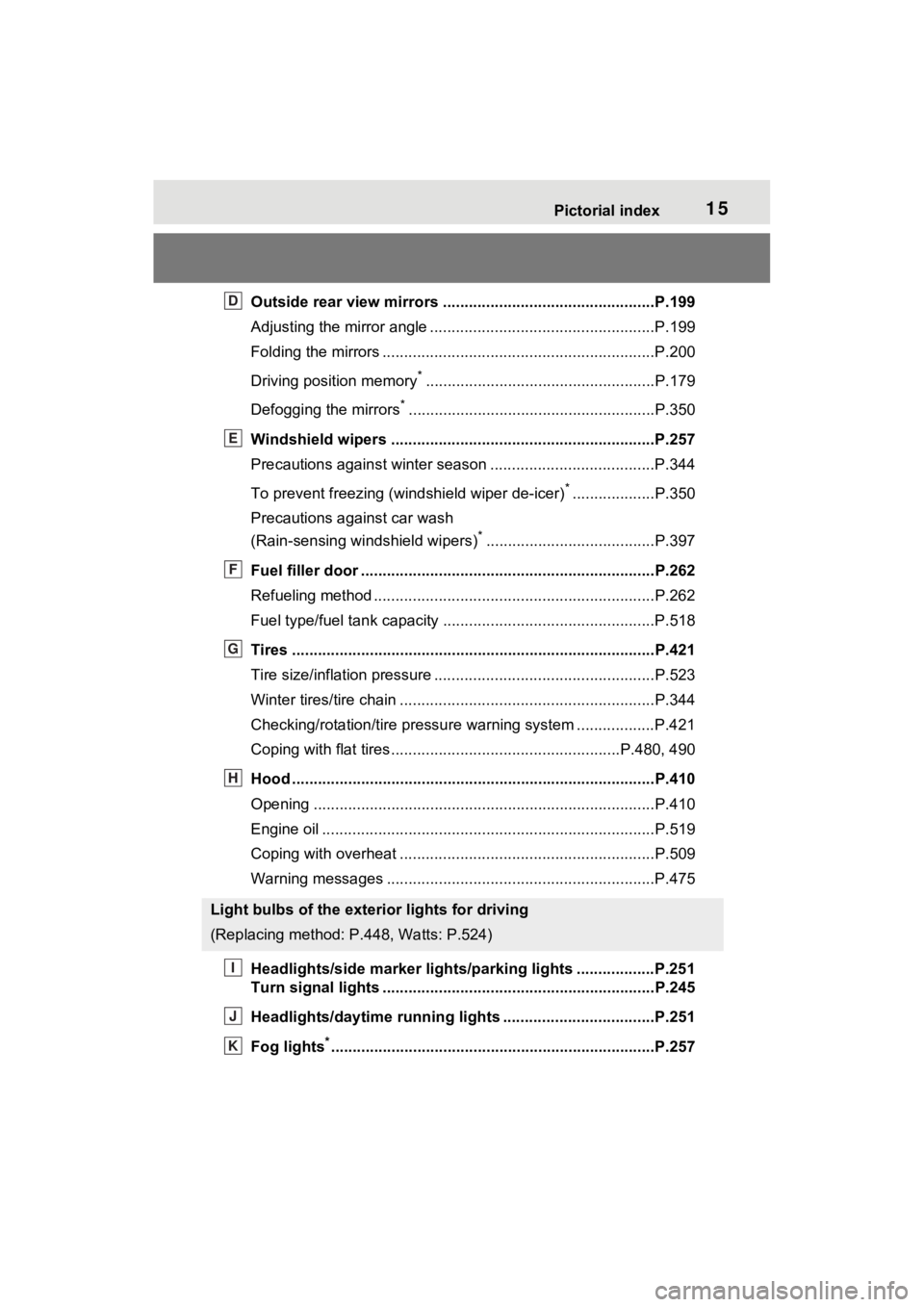
15Pictorial index
Outside rear view mirrors .................................................P.199
Adjusting the mirror angle ....................................................P.199
Folding the mirrors ...............................................................P.200
Driving position memory
*.....................................................P.179
Defogging the mirrors
*.........................................................P.350
Windshield wipers .............................................. ...............P.257
Precautions against winter season .............................. ........P.344
To prevent freezing (windshield wiper de-icer)
*...................P.350
Precautions against car wash
(Rain-sensing windshield wipers)
*.......................................P.397
Fuel filler door ............................................... .....................P.262
Refueling method ............................................... ..................P.262
Fuel type/fuel tan k capacity .................................................P.518
Tires ....................................................................................P.421
Tire size/inflation pressure ................................... ................P.523
Winter tires/tire chain ........................................ ...................P.344
Checking/rotation/tire pressur e warning system ..................P.421
Coping with flat tires......................................... ............P.480, 490
Hood ....................................................................................P.410
Opening ........................................................ .......................P.410
Engine oil ..................................................... ........................P.519
Coping with overheat ........................................... ................P.509
Warning messages ..............................................................P.475
Headlights/side marke r lights/parking lights ..................P.251
Turn signal lights ...............................................................P.245
Headlights/daytime running lights .............................. .....P.251
Fog lights
*............................................................... ............P.257
Light bulbs of the exterior lights for driving
(Replacing method: P.448, Watts: P.524)
D
E
F
G
H
I
J
K
Page 17 of 602
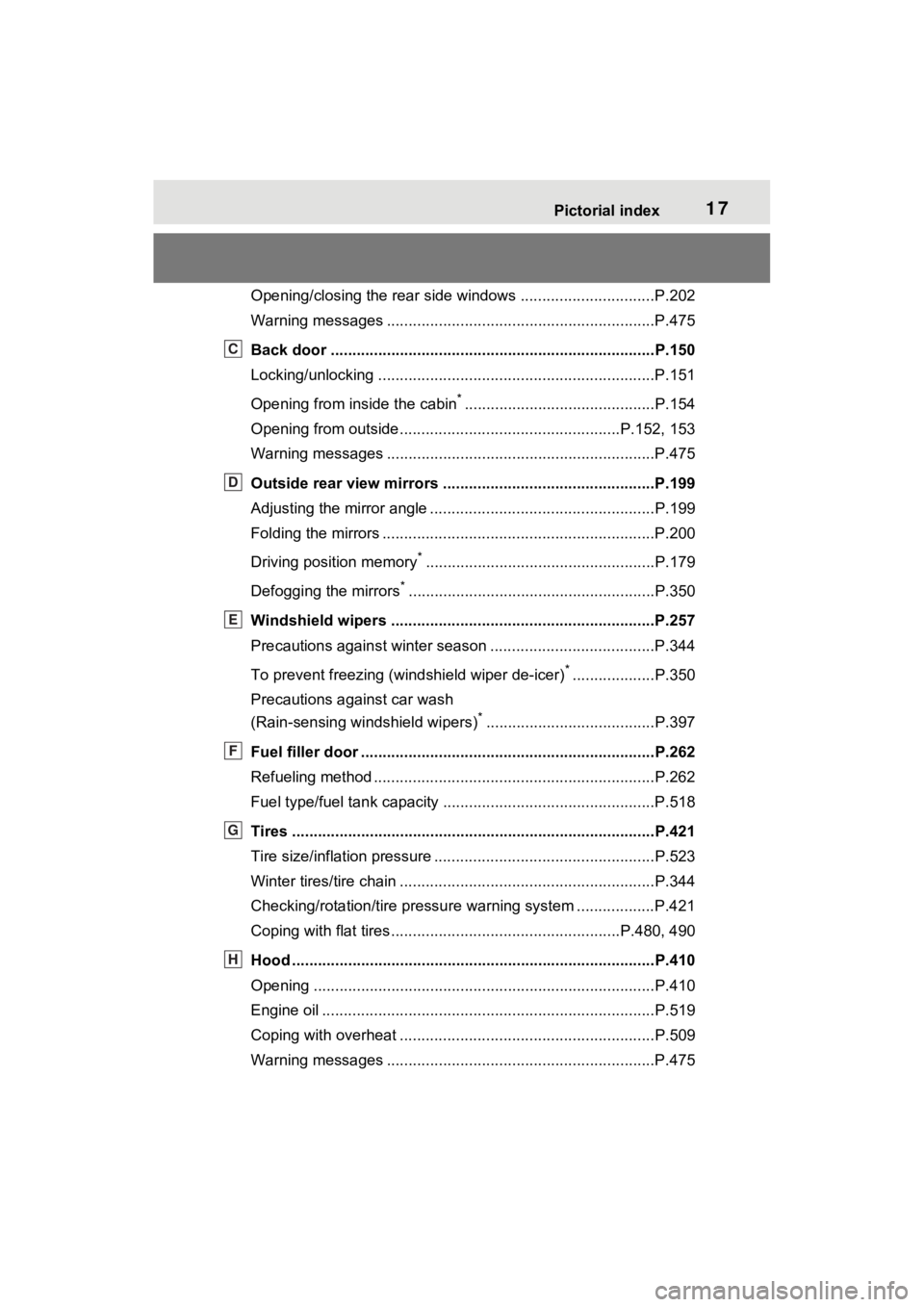
17Pictorial index
Opening/closing the rear side windows ...............................P.202
Warning messages ..............................................................P.475
Back door ...................................................... .....................P.150
Locking/unlocking ................................................................P.151
Opening from inside the cabin
*............................................P.154
Opening from outside........................................... ........P.152, 153
Warning messages ..............................................................P.475
Outside rear view mirrors .................................................P.199
Adjusting the mirror angle ..................................... ...............P.199
Folding the mirrors ...............................................................P.200
Driving position memory
*.....................................................P.179
Defogging the mirrors
*.........................................................P.350
Windshield wipers .............................................. ...............P.257
Precautions against winter season .............................. ........P.344
To prevent freezing (windshield wiper de-icer)
*...................P.350
Precautions against car wash
(Rain-sensing windshield wipers)
*.......................................P.397
Fuel filler door ............................................... .....................P.262
Refueling method ............................................... ..................P.262
Fuel type/fuel tan k capacity .................................................P.518
Tires ....................................................................................P.421
Tire size/inflation pressure ................................... ................P.523
Winter tires/tire chain ........................................ ...................P.344
Checking/rotation/tire pressur e warning system ..................P.421
Coping with flat tires......................................... ............P.480, 490
Hood ....................................................................................P.410
Opening ........................................................ .......................P.410
Engine oil ..................................................... ........................P.519
Coping with overheat ........................................... ................P.509
Warning messages ..............................................................P.475
C
D
E
F
G
H
Page 19 of 602

19Pictorial index
Opening/closing the front side windows...............................P.202
Locking/unlocking by using the mechanical key ..........P.133, 502
Warning messages ..............................................................P.475
Sliding doors .................................................. ....................P.137
Locking/unlocking ................................................................P.138
Opening/closing the sliding door ............................... ...........P.139
Opening/closing the rear si de windows ...............................P.202
Warning messages ..............................................................P.475
Back door ...................................................... .....................P.150
Locking/unlocking ................................................................P.151
Opening from inside the cabin
*............................................P.154
Opening from outside........................................... ........P.152, 153
Warning messages ..............................................................P.475
Outside rear view mirrors .................................................P.199
Adjusting the mirror angle ..................................... ...............P.199
Folding the mirrors ...............................................................P.200
Driving position memory
*.....................................................P.179
Defogging the mirrors
*.........................................................P.350
Windshield wipers .............................................. ...............P.257
Precautions against winter season .............................. ........P.344
To prevent freezing (windshield wiper de-icer)
*...................P.350
Precautions against car wash
(Rain-sensing windshield wipers)
*.......................................P.397
Fuel filler door ............................................... .....................P.262
Refueling method ............................................... ..................P.262
Fuel type/fuel tan k capacity .................................................P.518
Tires ....................................................................................P.421
Tire size/inflation pressure ................................... ................P.523
Winter tires/tire chain ........................................ ...................P.344
Checking/rotation/tire pressur e warning system ..................P.421
B
C
D
E
F
G
Page 94 of 602

942-1. Instrument cluster
*1: These lights turn on when the power switch is turned to ON to
indicate that a system check is
being performed. They will turn
off after the hybr id system is on,
or after a few seconds. There
may be a malfunction in a sys-
tem if the light does not come on,
or turn off. Have the vehicle
inspected by your Toyota dealer.
*2: This light illuminates on the multi-informatio n display with a
message.
*3: Intuitive parking assist OFF indi- cator turns on when the power
switch is turned to ON while the
Intuitive parking assist function is
on. It will turn off after a few sec-
onds.
*4: This light illumi nates on the cen-
ter panel.
The indicators inform the driver
of the operating state of the
vehicle’s various systems.
(Canada)
(Flashes)
Parking brake indicator
( P.470)
Tire pressure warning
light
*1 ( P.470)
Low fuel level warning
light ( P.470)
Seat belt reminder light
( P.471)
Rear passengers’ seat
belt reminder light
*4
( P.471)
WARNING
■If a safety system warning
light does not come on
Should a safety system light such
as the ABS and SRS warning light
not come on when you start the
hybrid system, this could mean
that these system s are not avail-
able to help protect you in an acci-
dent, which could result in death
or serious injury. Have the vehicle
inspected by your Toyota dealer
immediately if this occurs.
Indicators
Turn signal indicator
( P.245)
(U.S.A.)
Headlight indicator
( P.251)
(Canada)
Tail light indicator
( P.251)
Headlight high beam indi-
cator ( P.253)
Automatic High Beam
indicator ( P.253)
Fog light indicator (if
equipped) ( P.257)
Smart key system indica-
tor
*1 ( P.234)
Cruise control indicator
( P.291)
Dynamic radar cruise
control indicator
( P.291)
Page 116 of 602
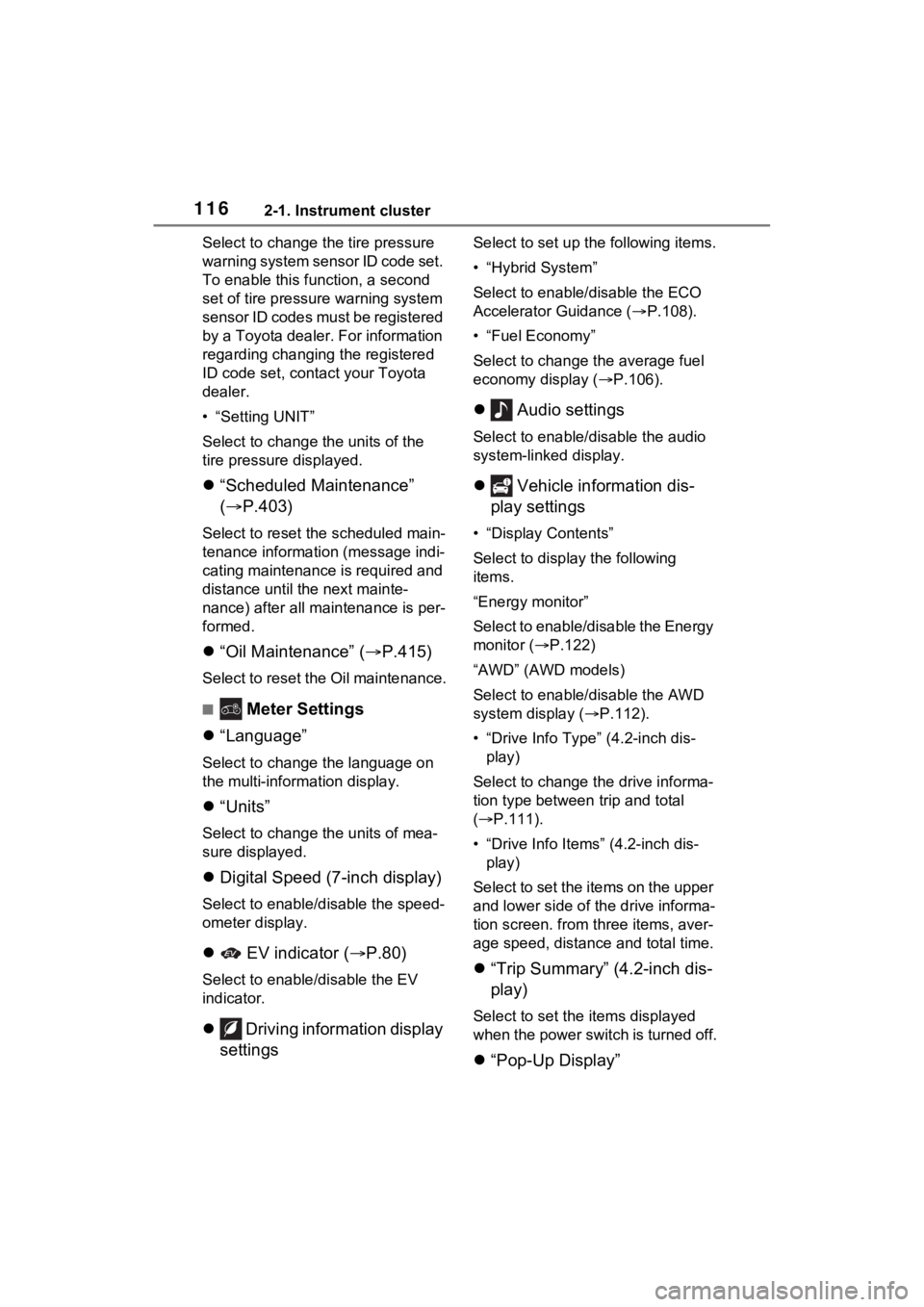
1162-1. Instrument cluster
Select to change the tire pressure
warning system sensor ID code set.
To enable this function, a second
set of tire pressure warning system
sensor ID codes must be registered
by a Toyota dealer. For information
regarding changing the registered
ID code set, contact your Toyota
dealer.
• “Setting UNIT”
Select to change the units of the
tire pressure displayed.
“Scheduled Maintenance”
( P.403)
Select to reset the scheduled main-
tenance information (message indi-
cating maintenance is required and
distance until the next mainte-
nance) after all maintenance is per-
formed.
“Oil Maintenance” ( P.415)
Select to reset the Oil maintenance.
■ Meter Settings
“Language”
Select to change the language on
the multi-inform ation display.
“Units”
Select to change t he units of mea-
sure displayed.
Digital Speed (7-inch display)
Select to enable/disable the speed-
ometer display.
EV indicator ( P.80)
Select to enable/disable the EV
indicator.
Driving information display
settings
Select to set up t he following items.
• “Hybrid System”
Select to enable/disable the ECO
Accelerator Guidance (P.108).
• “Fuel Economy”
Select to change the average fuel
economy display ( P.106).
Audio settings
Select to enable/disable the audio
system-linked display.
Vehicle information dis-
play settings
• “Display Contents”
Select to displa y the following
items.
“Energy monitor”
Select to enable/disable the Energy
monitor ( P.122)
“AWD” (AWD models)
Select to enable /disable the AWD
system display ( P.112).
• “Drive Info Type” (4.2-inch dis- play)
Select to change the drive informa-
tion type between trip and total
( P.111).
• “Drive Info Items” (4.2-inch dis- play)
Select to set the items on the upper
and lower side of the drive informa-
tion screen. from th ree items, aver-
age speed, distance and total time.
“Trip Summary” (4.2-inch dis-
play)
Select to set the items displayed
when the power switch is turned off.
“Pop-Up Display”
Page 264 of 602

2624-4. Refueling
4-4.Refueling
Close all the doors and win-
dows, and turn the power
switch to OFF.
Confirm the type of fuel.
■Fuel types
P.526
■Fuel tank opening for unleaded
gasoline
To help prevent incorrect fueling,
your vehicle has a fuel tank opening
that only accommodates the spe-
cial nozzle on unle aded fuel pumps.
Opening the fuel tank
cap
The fuel tank of your vehicle
has a special structure,
which requires a reduction
in fuel tank pressure before
refueling. After the opener
switch has been pressed, it
will take several seconds
until the vehicle is ready for
refueling.
Before refueling the vehi-
cle
WARNING
■When refueling the vehicle
Observe the following precautions
while refueling the vehicle. Failure
to do so may result in death or
serious injury.
●After exiting the vehicle and
before opening the fuel door,
touch an unpainted metal sur-
face to discharge any static
electricity. It is important to dis-
charge static electricity before
refueling because sparks result-
ing from static electricity can
cause fuel vapors to ignite while
refueling.
●Always hold the grips on the
fuel tank cap and turn it slowly
to remove it.
A whooshing sound may be
heard when the f uel tank cap is
loosened. Wait until the sound
cannot be heard before fully
removing the cap. In hot
weather, pressurized fuel may
spray out of the filler neck and
cause injury.
●Do not allow anyone that has
not discharged static electricity
from their body to come close to
an open fuel tank.
●Do not inhale vaporized fuel.
Fuel contains substances that
are harmful if inhaled.
●Do not smoke while refueling
the vehicle.
Doing so may cause the fuel to
ignite and cause a fire.
●Do not return to the vehicle or
touch any person or object that
is statically charged. This may
cause static electricity to build
up, resulting in a possible igni-
tion hazard.
Page 345 of 602
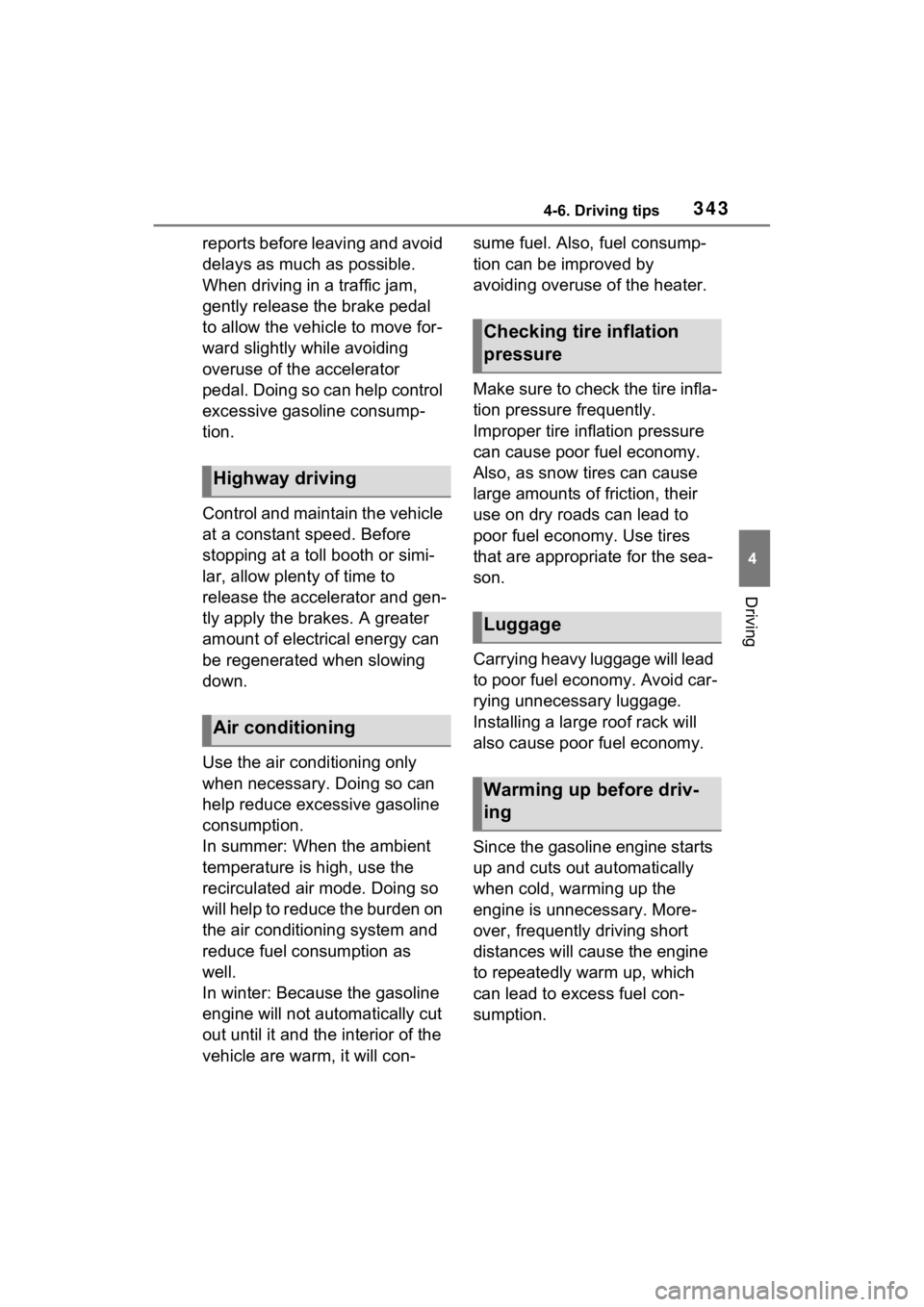
3434-6. Driving tips
4
Driving
reports before leaving and avoid
delays as much as possible.
When driving in a traffic jam,
gently release the brake pedal
to allow the vehicle to move for-
ward slightly while avoiding
overuse of the accelerator
pedal. Doing so can help control
excessive gasoline consump-
tion.
Control and maintain the vehicle
at a constant speed. Before
stopping at a toll booth or simi-
lar, allow plenty of time to
release the accelerator and gen-
tly apply the brakes. A greater
amount of electrical energy can
be regenerated when slowing
down.
Use the air conditioning only
when necessary. Doing so can
help reduce excessive gasoline
consumption.
In summer: When the ambient
temperature is high, use the
recirculated air mode. Doing so
will help to reduce the burden on
the air conditioning system and
reduce fuel consumption as
well.
In winter: Because the gasoline
engine will not automatically cut
out until it and the interior of the
vehicle are warm, it will con-sume fuel. Also, fuel consump-
tion can be improved by
avoiding overuse of the heater.
Make sure to check the tire infla-
tion pressure frequently.
Improper tire inflation pressure
can cause poor fuel economy.
Also, as snow tires can cause
large amounts of friction, their
use on dry roads can lead to
poor fuel economy. Use tires
that are appropriate for the sea-
son.
Carrying heavy luggage will lead
to poor fuel economy. Avoid car-
rying unnecessary luggage.
Installing a large roof rack will
also cause poor fuel economy.
Since the gasoline engine starts
up and cuts out automatically
when cold, warming up the
engine is unnecessary. More-
over, frequently driving short
distances will cause the engine
to repeatedly warm up, which
can lead to excess fuel con-
sumption.
Highway driving
Air conditioning
Checking tire inflation
pressure
Luggage
Warming up before driv-
ing
Page 408 of 602

4066-2. Maintenance
The OBD system determines
that a problem exists some-
where in the emission control
system. Your vehicle may not
pass the I/M test and may need
to be repaired. Contact your
Toyota dealer to service the
vehicle.
When the 12-volt battery is
disconnected or discharged
Readiness codes that are set
during ordinary driving are
erased.
Also, depending on your driv-
ing habits, the readiness
codes may not be completely
set.
When the fuel tank cap is
Vehicle exterior
ItemsCheck points
Doors
• Do the doors
operate
smoothly?
Engine hood
• Does the engine hood lock system
work properly?
Fluid leaks
• There should not be any signs of
fluid leakage
after the vehicle
has been parked.
Tires
• Is the tire infla-tion pressure
correct?
• The tires should not be damaged
or excessively
worn.
• Have the tires been rotated
according to the
maintenance
schedule?
• The wheel nuts should not be
loose.
Windshield
wipers/rear
window wiper
• The wiper blades should not show
any signs of
cracking, split-
ting, wear, con-
tamination or
deformation.
• The wiper blades should clear the
windshield/rear
window without
streaking or skip-
ping.
Emission inspection
and maintenance (I/M)
programs
Some states have vehicle
emission inspection pro-
grams which include OBD
(On Board Diagnostics)
checks. The OBD system
monitors the operation of
the emission control sys-
tem.
If the malfunction indica-
tor lamp comes on
Your vehicle may not
pass the I/M test in the fol-
lowing situations: